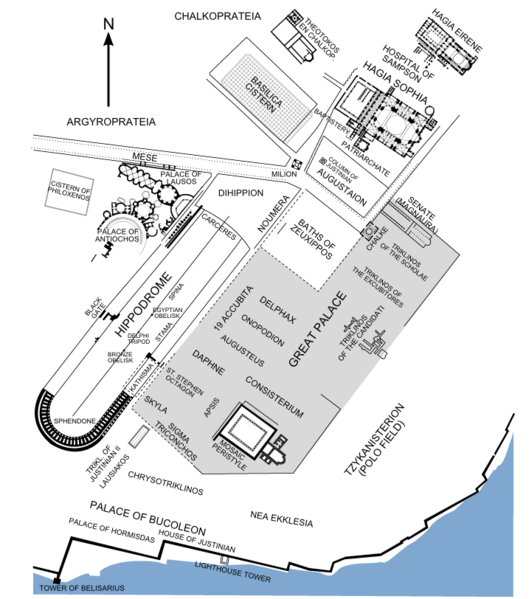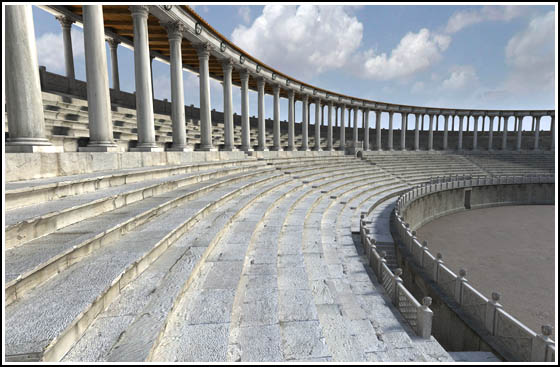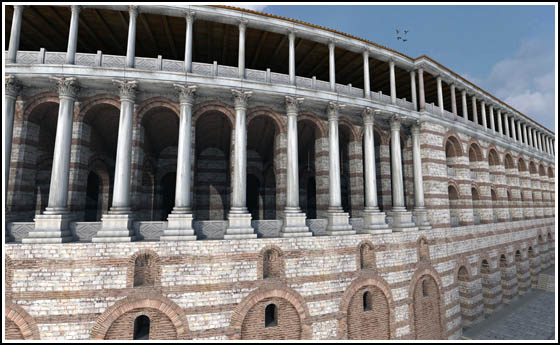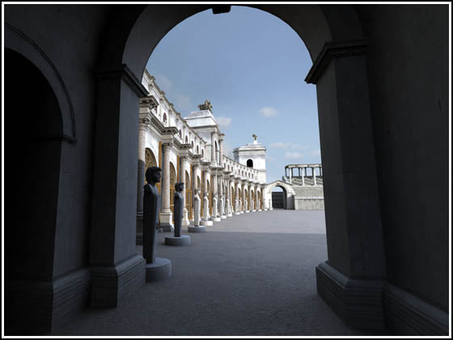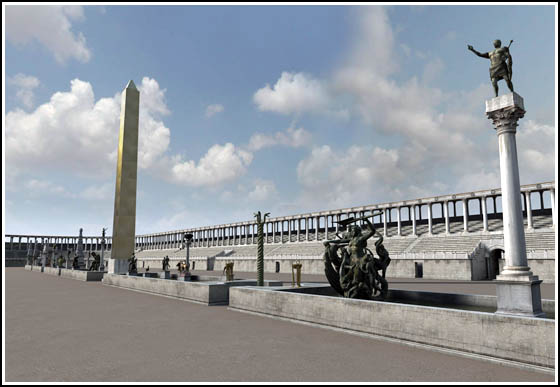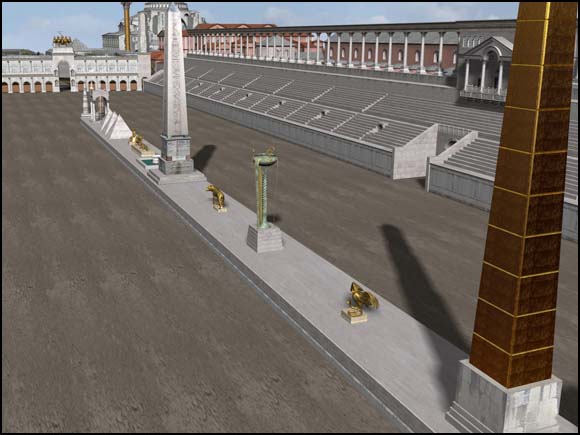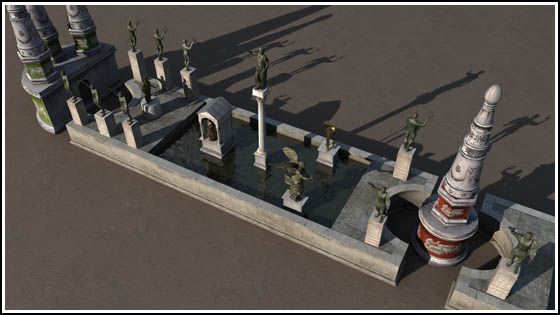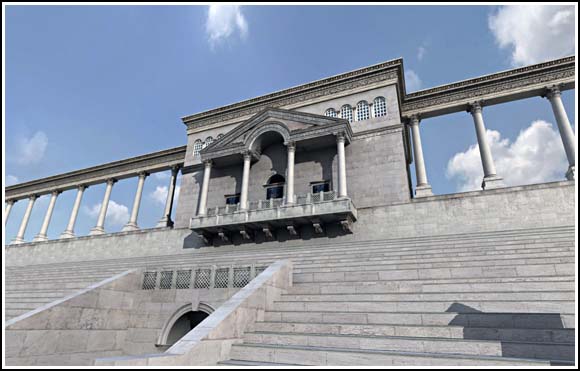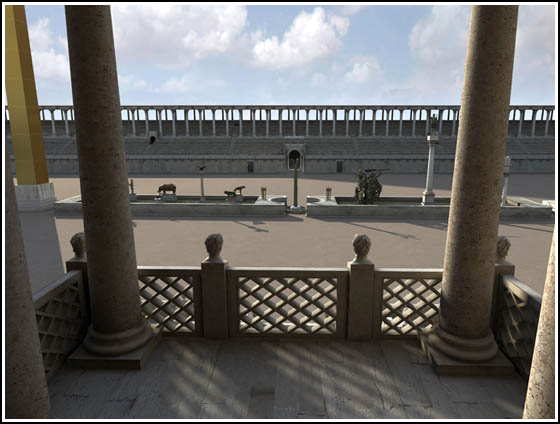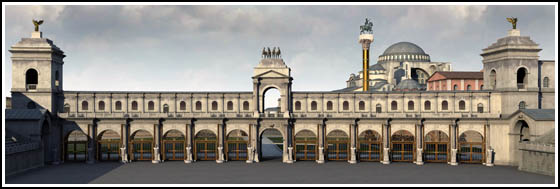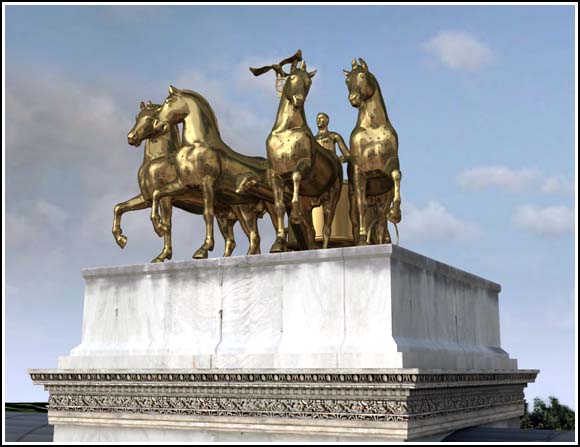by Michael Balaroutsos architect
Thanks for the valuable assistance of the teacher Nicholas Ntalakoudis
People of Chios are well known the existence of the 4 gold horses of the island, in San Marco of Venice where they remain until today.
This masterpiece of the most impressive manipulated Greek antiquities , was constructed in the period 100-400 AD and was part of a gold-plated quadriga chariot with charioteer - (The HISTORY says it was made by Lysippos 400 BC).
Moved in Constantinople in the first half of the fifth century AD by Emperor Theodosius II who had no further work to do of which was a will-less creature (from natural and deliberate education), it concerned itself, and does not let him deal with work of the Emperor and was exploited throughout all his life by the family, courtiers and priests.
The tethrippon was placed in the Hippodrome, in a central position above the main entrance of the stadium, which had a length of almost half a kilometer! From that point just started and where horse-chariot through the gates of 12 horses went out of Blues, Green, Red and White in the arena in the cheers of about 100,000 spectators (!!!) who phages between them much like today's Fans of large groups and to be more precise rather worst.
After the conquest of Constantinople by the Francs in 1204, apart from the Hippodrome, which ceased to function (do not flush by the Church), horses dismantled and transferred to Venice and placed above the main entrance of the Basilica of San Marco. later stole Napoleon, but less than 20 years later, in 1815, France has obliged to return (with war, of course not with compilations of signatures). In recent decades, from 1977 or 1980, is inside the temple and outside is placed the replicas .
The curious is that foreign sources (mainly Italian) and Greek (which obviously copied from the Italians) states that removed from the Arch of Trajan in Rome by Constantine the Great and moved to Constantinople from where "brought back " in 1204 by the Doge of Venice. Indeed is noted that the Doge was interested only for the horses and nothing else, perhaps as an emblem of the conquest of Constantinople (in Hippodrome, apart from races become any important events, celebrations and the special executions).
Some of sources said that the horses are Greek antiquity, others not, but in addition to the possibility of existed before in the Arch of Trajan, and alleged hypothesis that by the Rhodian was dedicated at Delphi where stolen from Neron and placed in the arch and later adorned the Arch of Trajan.
THE PALACE, THE HIPPODROME AND MUNICIPALITIES
Very little is known about the once famous imperial and aristocratic palaces adorned Constantinople.
The Grand Palace will serve as the imperial residence and administrative center, was a complex of buildings dating back to different eras and in different forms.
The main task then was that of Constantine the Great Palace, the sacred palace.
In what was probably the apartments of the imperial family, and buildings for government departments, rooms for guests, dining, churches and chapels, buildings for the garrison and artisan workshops.Among the buildings will also be there arcades, courtyards, gardens, fountains, artwork and flowers and rare plants.
Here are pictures of a possible reconstruction of the palace
Near the palace was the hippodrome. It was built to a standard shape and had Colosseum U. Its capacity is estimated to reach the 100,000 spectators, while the total length of approximately 450 meters.
In the northeast edge of midnight there were gates or doors equipped with a device that allowed the simultaneous opening. This was the starting point of the chariot. In the center of the arena was a small dam around which were the chariot races, and at each end of a pole delimited the turning point
.In the middle of the east side of the horse, was the imperial (seat), which was linked to the Grand Palace by spiral staircase.
The main spectacle of horse racing was that the thousands of spectators watched from the stands and the emperor of the gallery. Sometimes they were and joust or chariot races and other rare events like circuses. You were never fights but now, having not kept pace this "spectacle"with the ideas of Christianity.
During the race, viewers have submitted requests or complaints to the emperor.
The races are organized townships, which were clubs with members and supporters. Each municipality is different from the color of uniforms and banners used by and took their name from it. So called Venetians (blue), green, white and red. Indeed, the common passion for winning teams led to quarrels between them.
source souliot
Hippodrome has now become a very touristic place promenade,known as «Sultanahmet Meydanı» (position of the Sultan-Ahmet), or «At Meydanı» (place horses). Survived and the
two columns were placed in the center of Theodosius (obelisk) and Constantine (column).
obelisk of Theodosius
source kkajoll
column of Constantine
source kkajoll
Over the start of racing was The 4 golden horses of Chios that were built by the sculptor Lysippos
The last race, however, should not be done only when the horses return to Chios for the decoration of which were originally built, as is the cultural heritage of Greece
Thanks for the valuable assistance of the teacher Nicholas Ntalakoudis
People of Chios are well known the existence of the 4 gold horses of the island, in San Marco of Venice where they remain until today.
This masterpiece of the most impressive manipulated Greek antiquities , was constructed in the period 100-400 AD and was part of a gold-plated quadriga chariot with charioteer - (The HISTORY says it was made by Lysippos 400 BC).
Moved in Constantinople in the first half of the fifth century AD by Emperor Theodosius II who had no further work to do of which was a will-less creature (from natural and deliberate education), it concerned itself, and does not let him deal with work of the Emperor and was exploited throughout all his life by the family, courtiers and priests.
The tethrippon was placed in the Hippodrome, in a central position above the main entrance of the stadium, which had a length of almost half a kilometer! From that point just started and where horse-chariot through the gates of 12 horses went out of Blues, Green, Red and White in the arena in the cheers of about 100,000 spectators (!!!) who phages between them much like today's Fans of large groups and to be more precise rather worst.
After the conquest of Constantinople by the Francs in 1204, apart from the Hippodrome, which ceased to function (do not flush by the Church), horses dismantled and transferred to Venice and placed above the main entrance of the Basilica of San Marco. later stole Napoleon, but less than 20 years later, in 1815, France has obliged to return (with war, of course not with compilations of signatures). In recent decades, from 1977 or 1980, is inside the temple and outside is placed the replicas .
The curious is that foreign sources (mainly Italian) and Greek (which obviously copied from the Italians) states that removed from the Arch of Trajan in Rome by Constantine the Great and moved to Constantinople from where "brought back " in 1204 by the Doge of Venice. Indeed is noted that the Doge was interested only for the horses and nothing else, perhaps as an emblem of the conquest of Constantinople (in Hippodrome, apart from races become any important events, celebrations and the special executions).
Some of sources said that the horses are Greek antiquity, others not, but in addition to the possibility of existed before in the Arch of Trajan, and alleged hypothesis that by the Rhodian was dedicated at Delphi where stolen from Neron and placed in the arch and later adorned the Arch of Trajan.
THE PALACE, THE HIPPODROME AND MUNICIPALITIES
Very little is known about the once famous imperial and aristocratic palaces adorned Constantinople.
The Grand Palace will serve as the imperial residence and administrative center, was a complex of buildings dating back to different eras and in different forms.
The main task then was that of Constantine the Great Palace, the sacred palace.
In what was probably the apartments of the imperial family, and buildings for government departments, rooms for guests, dining, churches and chapels, buildings for the garrison and artisan workshops.
Here are pictures of a possible reconstruction of the palace
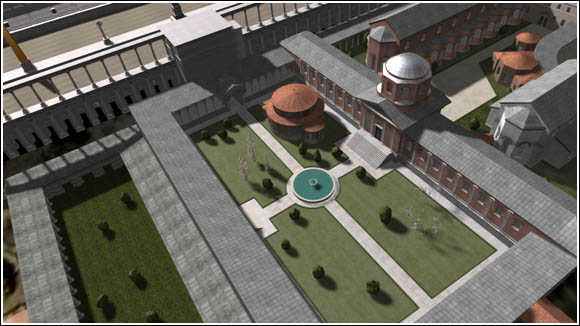 |
| Galleries, gardens, courtyards, fountains and many apartments were the sacred palace |
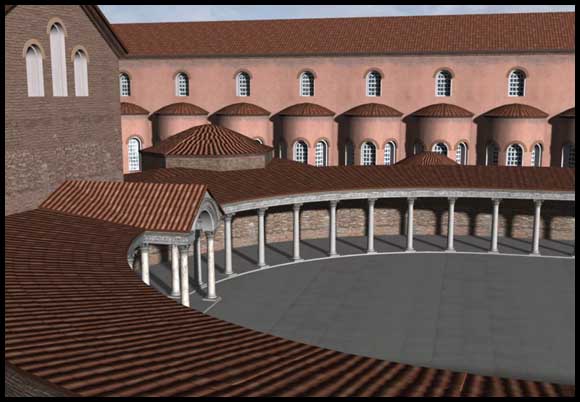 |
| The Avgoustaion was a public square, south of St. Sophia and was somehow the courtyard of the palace |
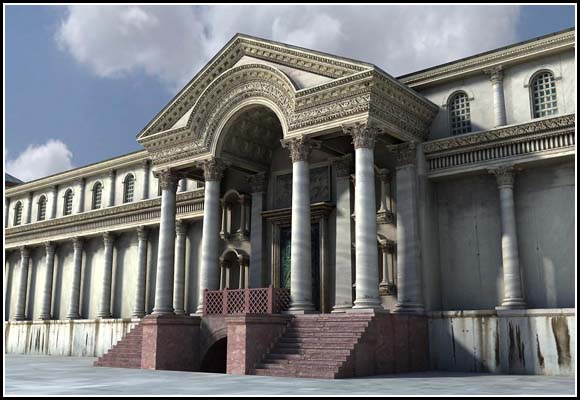 |
| The oldest part of the Grand Palace, the Palace of Daphne, as was said |
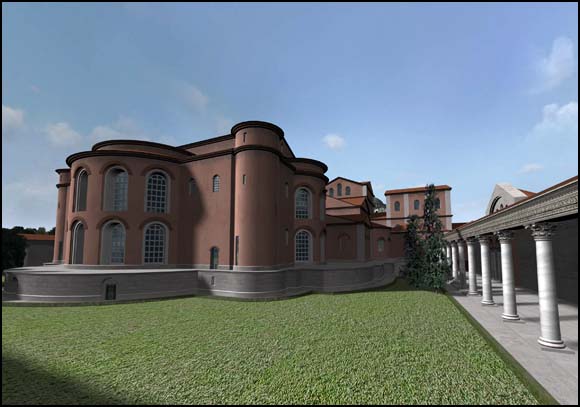 |
| The baths Zeuxippe was near the palace and Avgoustaio |
| The entrance to the "Seat" the special position of the emperor in the Hippodrome. Used only by members of the royal family |
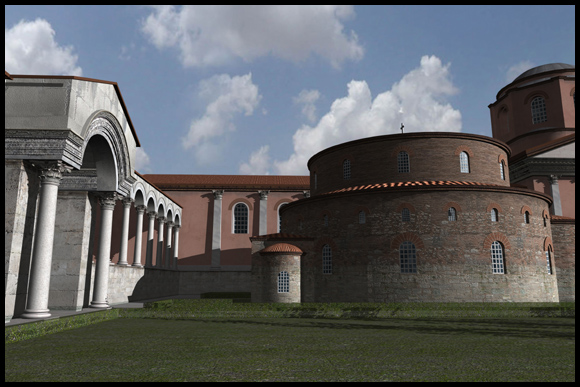 |
| The entrance to the "Seat" and next to St. Stephen |
In the northeast edge of midnight there were gates or doors equipped with a device that allowed the simultaneous opening. This was the starting point of the chariot. In the center of the arena was a small dam around which were the chariot races, and at each end of a pole delimited the turning point
The main spectacle of horse racing was that the thousands of spectators watched from the stands and the emperor of the gallery. Sometimes they were and joust or chariot races and other rare events like circuses. You were never fights but now, having not kept pace this "spectacle"with the ideas of Christianity.
During the race, viewers have submitted requests or complaints to the emperor.
The races are organized townships, which were clubs with members and supporters. Each municipality is different from the color of uniforms and banners used by and took their name from it. So called Venetians (blue), green, white and red. Indeed, the common passion for winning teams led to quarrels between them.
Byzantine Empire Hippodrome of Constantinople - Sultanahmet
source souliot
two columns were placed in the center of Theodosius (obelisk) and Constantine (column).
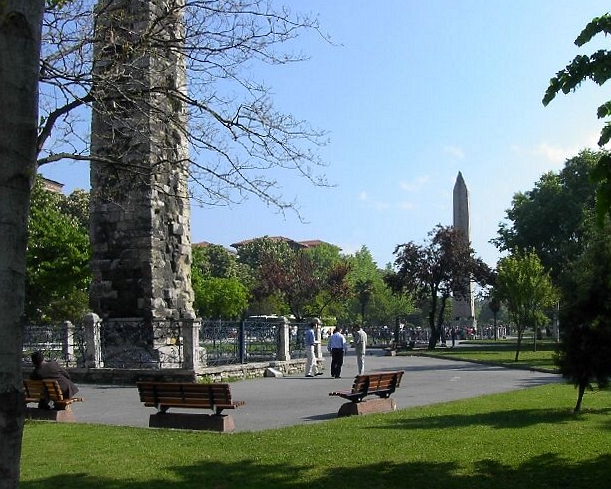 |
| Hippodrome today |
source kkajoll
column of Constantine
source kkajoll
Over the start of racing was The 4 golden horses of Chios that were built by the sculptor Lysippos

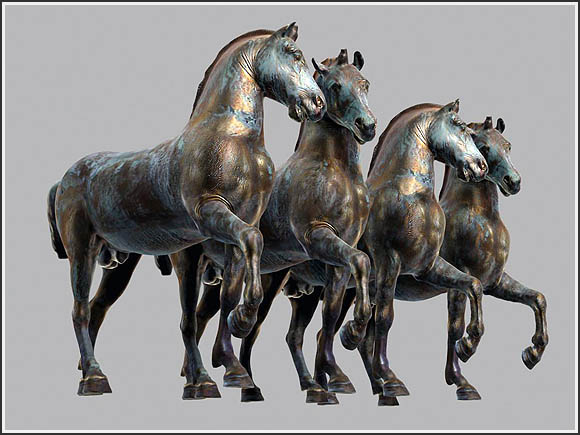
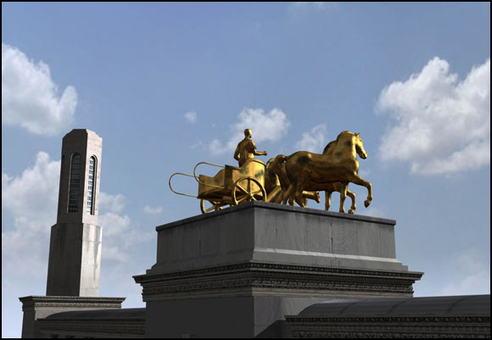
_qqvnajozqavyn2ebs43h7r.jpg)

